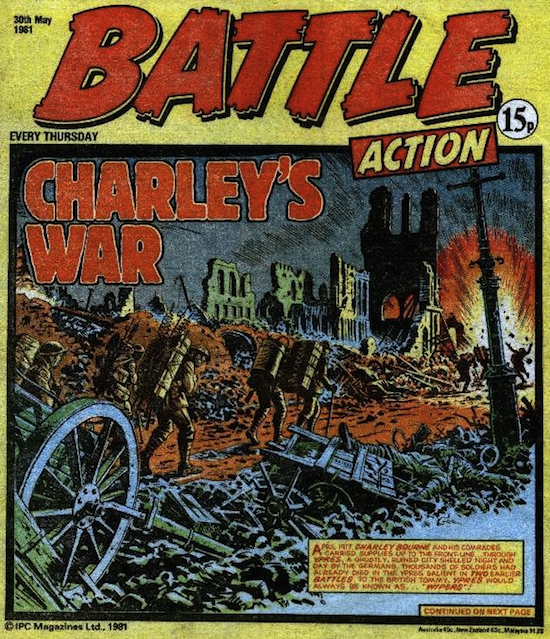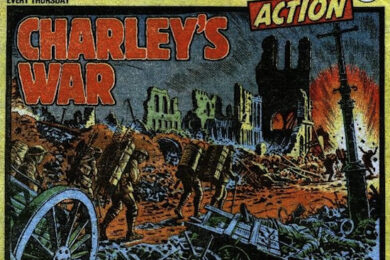Battle Picture Weekly! To readers of a certain age, mention of this comic instantly brings them back to their childhood. Now, thanks to Titan Books’ reissues of the best of Battle’s stories in graphic novel format, that generation can relive its youth, while new readers will see just why Battle was so important to so many.
Battle Picture Weekly (as it was initially called, also known at various times as Battle Action, Battle Action Force, Battle with Storm Force, and simply Battle) began its lengthy print run with the issue dated 8 March 1975, lasting until 23 January 1988 when publisher IPC Magazines merged it with Eagle. This was a common occurrence in the days when Britain had a comic industry. You’d go to the newsagent with your pocket money to buy your favourite comic, and notice, to your horror that it had ‘great news, chums’ emblazoned on the cover. Experienced comic readers (and there were a great many of them in those days), knew this to be a euphemism for bad news. The ‘good news chums’ banner appeared when publishers felt sales levels had fallen too low (although what was low then would be utterly massive now!). The publisher would decree that this title would be cancelled and merge it with another, bringing two or three of its top stories, and hopefully some of its readers, along with it. This approach led to the continuation of the Strontium Dog series in 2000AD, which originally ran in 1978’s short-lived Starlord. It is also worth mentioning that the Hammerstein character in 2000AD’s popular ABC Warriors originally came from a gem of a Starlord series called Ro-Busters (a wicked robotic inversion of Thunderbirds, featuring scripts from The Guvnor of British Comics, Pat Mills, with the characters designed by Kevin O’Neill of League of Extraordinary Gentlemen and Marshall Law fame). However, while this tactic worked when Britain’s comic industry thrived, as the 80s drew near, the law of diminishing returns set in. It is a shame that British comics didn’t follow the template that Pat Mills and his talented team of writers and artists used on such titles as Action, Battle, 2000AD and Misty. There might still be a thriving comics industry in the UK now had it been maintained and allowed to grow.
The deathblow for Battle came between 1983-86, when after several years of building the brand, it was undermined by a tie-in with the Action Force range of toys. Charley’s War this most certainly wasn’t and it undid all the hard work thus far. You now had the shameful situation of creators, some of whom had actually been in the army, trying to breath life into stories based on moulded plastic. Where Battle was a progression on what had come before, Battle Action Force lost ground, and once the tie-in was over Battle could only limp like a mortally wounded soldier to its sad resting place with the Eagle comic. It has to be remembered that pre-toy-tie-ins Battle was an outstanding success, and a great many of its stories stand up very well today due to the quality of the scripts. Battle’s stories were written by the likes of John Wagner (co-creator of the recently filmed Judge Dredd), Gerry Finley-Day, Alan Hebden, Tom Tully, and Pat Mills (whose ground-breaking Action comic would eventually be merged with Battle). Battle was no slouch in the artistic department either, featuring as it did fine work from Carlos Ezquerra, Mike Western, Eric Bradbury, Joe Colquhoun, Mike Dorey, and Cam Kennedy, to mention but a few.
Sadly, for many years none of Battle’s stories were available in graphic novel format. So great kudos are due to Titan, who, as we entered the 21st century, began to reprint, in high-quality hardcover format, Pat Mills and Joe Colquhoun’s classic Charley’s War. A combination of well-researched and heartfelt scriptwriting, Pat’s work is the antithesis of the ‘war is hell’ gung-ho Sergeant Rock-style story. While never doubting for a second the heroism of the brave men in the trenches, The Great War is shown to be the tragedy it was, a meat-grinder that took the lives of millions of soldiers and set the stage for the even greater horrors of World War Two. On a personal note, Charley’s War was the first comic I ever read to show the heroism of the many thousands of Irish soldiers who fought in The Great War. Hitherto we were portrayed, if at all, as ignorant savages, vilely insulting caricatures the likes of which even Punch would have hesitated to use (one notable earlier example in comics featured an Irish soldier who went into the fray with a pot of Irish stew). The artwork for Charley’s War was provided by Joe Colquhoun, one of comics’ great unsung heroes. The Gustave Doré of British comics, Colquhoun created beautiful expressive storytelling week-in week-out. Both Joe and Pat put their hearts into Charley’s War, and readers of all ages were drawn to the care evident in their work.
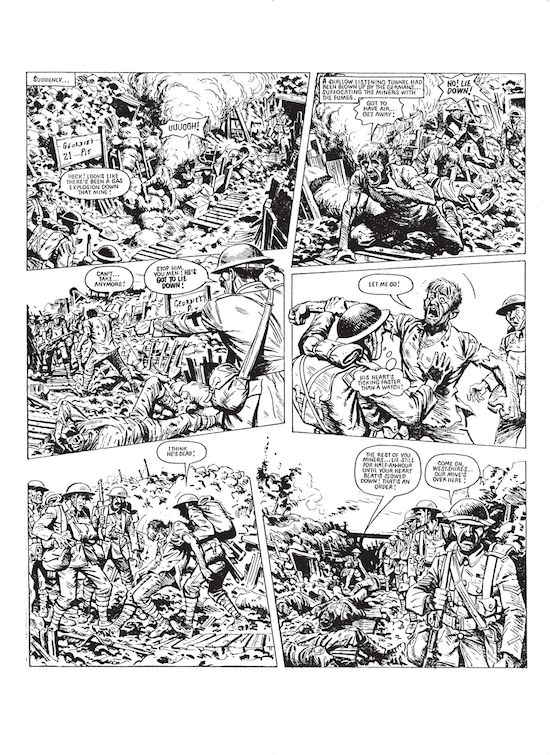
Charley’s War © 2012 Egmont UK Ltd. All Rights Reserved.
While continuing to reprint Charley’s War, Titan have expanded their range to include other Battle characters. Major Eazy’s story starts with the beautifully bound hardcover ‘Heart of Iron’. Extremely well scripted by Alan Hebden and drawn by the legendary co-creator of Judge Dredd, Carlos Ezquerra, this work just oozes excitement. Ezquerra’s artwork is a glorious collision between spaghetti western dynamics and superb storytelling (Hebden and Ezqueraa also did an intriguing spaghetti western series entitled El Mestizo set during the American Civil War, unusual not only for its setting but for featuring an African-American anti-hero). Major Eazy himself is like a cross between James Coburn and Clint Eastwood, which is the kind of thing Pat Mills did as editor of Action, taking inspiration from stories and films that were popular at the time – Hellman of Hammer Force is very Sven Hassel meets Cross of Iron, Spinball was Death Race 2000 meets Rollerball, Hookjaw was Jaws with an ecological twist. As a bonus, ‘Heart Of Iron’ features an excellent interview with Alan Hebden. Also released in 2012 was Rat Pack: Guns, Guts and Glory. Drawing inspiration from the film The Dirty Dozen, Rat Pack is another excellent Battle story. Created by Carlos Ezquerra and the splendidly named Gerry Finley-Day, both would continue to work on the title whilst also bringing in the talents of Pat Mills, John Wagner, and 2000AD legend, the late Italian artist Massimo Belardinelli. Gerry Finley-Day is another unsung hero of British comics (he would go on to co-create Rogue Trooper and the classic Fiends on the Eastern Front), and his work deserves to be seen by a modern audience. There’s more creativity in one of Gerry’s scripts than a hundred by any of the hungry hacks who’ve ‘taken over’ his characters over the years.
The latest volume of Charley’s War (the ninth! Which shows a splendid commitment to the story on Titan’s part), is entitled ‘Death From Above’, and shows how Pat Mills and Joe Colquhoun managed to present the war at home as well as in the trenches. As always, Pat’s scripts are a master-class in how to write spandex-free comics, and as for Joe’s superb artwork, in Pat’s own words: “The air war is drawn with astonishing accuracy and power by Joe. Today, we have been conditioned to the ideas of civilians being a ‘legitimate’ target or simple ‘collateral damage’, but in 1918 the aerial bombing on non-combatants was rightly regarded as murder.” Elsewhere, the depiction of the world’s first tank battle is riveting. The reader can feel the fury of these metal behemoths ushering in a new era of 20th century warfare. Elsewhere, we see Charley’s court-martial, a superb piece of drama, that again shows that the strength of Charley’s War is that it deals with ordinary people like you or I. The highlight of the book is the incredible portrayal of naval warfare as experienced by Charley’s cousin Jack, a clever idea on Pat’s part to give views of different arenas of The Great War. And that artwork…it’s like a time machine. With a commentary from Pat Mills and a superb article on shellshock, Titan have done Charley the justice it deserves, complete with fine binding and high quality paper showing the art to maximum effect.
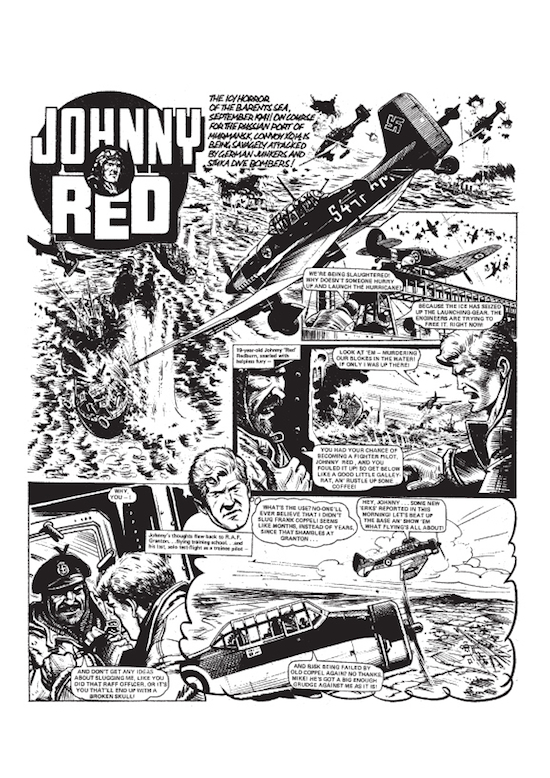
Johnny Red © Egmont UK Ltd 2012.
Finally, Titan have reprinted one of Battle’s most loved characters, Johnny Red. ‘Falcon’s First Flight’ is written by Tom Tully (who, for many years wrote the much-loved Roy of the Rovers, and like Joe Colquhoun and Gerry Finley-Day, another criminally overlooked talent of British comics) and illustrated by the great Colquhoun. Johnny Red is ‘Charley’s War in the air’, but so much more than that. Both Joe and Tom have done an incredible job of capturing the horror of what the Russians still call ‘The Great Patriotic War’. It fits in so well with the British comics’ revolution of the 70s – unromantic, brutal, but heroic. Telling the story of a British pilot fighting with a group of Russians against the Germans in World War Two, it’s not surprising that Johnny Red became the longest-running strip in Battle. It ran for an incredible ten years, and ‘Falcon’s First Flight’ illustrates why in fine style!
The final words for this piece go to someone who was there at the birth of Battle, The Guvnor himself, Mr. Pat Mills.
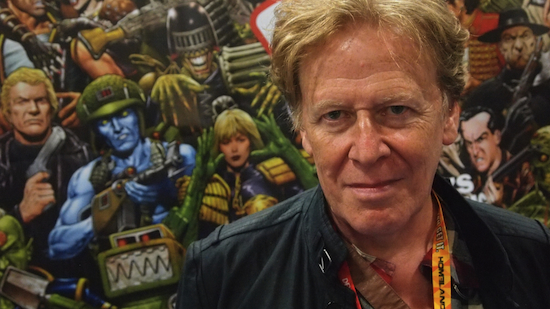
Pat, how did you get involved with Battle?
Pat Mills: John Wagner and I created Battle. This was because boys’ comics were falling apart and selling badly, so they needed to change things.
Did you suffer from managerial interference or did the publisher support you?
PM: The publisher supported us one hundred per cent but we faced a lot of passive aggression from the Boys’ Comic Department. They couldn’t stop us but they tried.
Can you talk a little about the contribution of Dave Hunt, a man that sadly many of the readers won’t be familiar with?
PM: Dave took over from us as editor. The biggest compliment I can pay him is to say that whereas I had some reservations on editors who took over on my other projects, I had no reservations on Dave. He did a brilliant job. He also did something unique. He took Joe Colquhoun off Johnny Red and gave him to me on Charley’s War. That was a very brave thing to do. To take an artist off a number one story and start him on a risky World War One story. It worked but no editor today would do the equivalent. So Dave is very much part of the success of Charley.
Gerry Finley-Day is one of the great unsung heroes, not just ofBattle, but of 70s and 80s British comics in general. Like yourself and Alan Grant, he also made a very strong contribution to girls’ comics. Another area, like Gerry himself, somewhat whitewashed from British comics’ history.
PM: I agree. Gerry started the Comic Revolution by creating Tammy. Today, Rogue Trooper is optioned as a film. At one time Grant Morrison was going to write the screenplay. I don’t know if this is still so.
Both you and Joe Colquhoun created what I believe to be not only one of the most important British comic stories, but also one of the best pieces of literature in any genre on The Great War. Are you disappointed that no one has tried to create work with the same realistic take on warfare in British comics?
PM: Yes. I distance Charley from all other war stories. The truth is that no one in the industry wants to write an anti-war story. It’s a very conservative industry.
In my introduction to this feature I describe Joe as the Gustave Doré of British comics. Could you share with us your personal impressions of Joe? I know from previous conservations with you that you hold him in high esteem.
PM: He was a genius. I believe the greatest comic artist Britain has produced. And a very humble man. When I left Charley, I offered him Slaine but he said he didn’t have the imagination. His work celebrates the working class as heroes. That’s why the brilliant Frank Hampson is held in higher regard, because he celebrated the middle-class as heroes. Joe uniquely celebrated ordinary people as heroic. It’s why the establishment will continue to ignore him. Charley’s War is too great a threat. Look at the Boy’s Own shit of Prince Harry as a hero in an imperialist war. We still live in Victorian times.
Sadly, that’s all too true. I feel you were ahead of your time with Charley’s War. For instance, the recent television adaptation of Birdsong pulled no punches in showing the carnage of the human meat-grinder that the trenches truly were.
PM: Yes. It featured the tunnels under the trenches and Charley did the same.

Charley’s War © 2012 Egmont UK Ltd. All Rights Reserved.
Battle has sadly been absent for well over two decades now. What are your thoughts on this, Pat? Could it have survived and thrived, and could Battle be brought back? There are so many different wars, past and present, that there is a wealth of material there for new stories.
PM: I agree, Steve. Charley’s War now sells very well in France so the market is definitely there. Battle died because the people who took over from Dave Hunt didn’t care. No reason why it couldn’t work today. For instance Commando continues, but there’s no chance because there is no desire by publishers to reach kids. It’s all fantasy and fans.
Which neatly brings me to my next question, Pat. Many comics today are created by what could be described as ‘armchair warriors’, inspired only by what has come before, with little experience of danger, perhaps even lacking knowledge of the comradeship of hard physical work under difficult conditions. I know from past conversations with you that Gerry Finley-Day was in the Territorial Army, and Eric Bradbury served in World War Two. Do you feel this brought a special edge of realism to the comic?
PM: Absolutely. It’s why readers love Gerry’s work. I edited a Rogue Trooper for Gerry last year and got him back into print. Readers were overjoyed! Me too! But because of contract problems it’s unlikely to happen again. I believe Andy Diggle is now writing Rogue Trooper.
A fact which speaks volumes in itself. Is there anyone else unsung from your days with Battle that deserves mention?
PM: Gerry wrote the lead stories of D-Day Dawson and Rat Pack. John Sanders, my publisher, came up with the idea of Day of the Eagle – the plan for a British agent to kill Hitler. Excellent!
My feeling is that you and the others working on Battle created the stories to read by a wide readership of ordinary people from all walks of life, as opposed to the narrow and inward-looking exclusive group that makes up much of comic readership today. Put simply, I see Charley’s War as something that anyone could buy in Waterstones and enjoy as opposed to some self-referencing ‘superhero’ comic written to appeal to a clique that frequents comic-shops. Would you agree?
PM: Oh, yeah. I keep trying. Maybe digital will finally give comics back to the people they were intended for. We have lost sales because of the path taken.
Finally, Pat, is there anything you would like to add?
PM: I did a straw poll on comics and young kids today still rate the early stories. At some point on my new blog I will outline some Battle stories that could run today!

